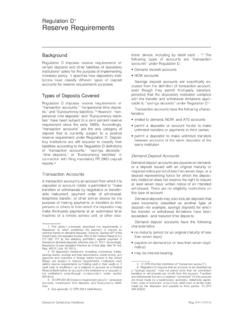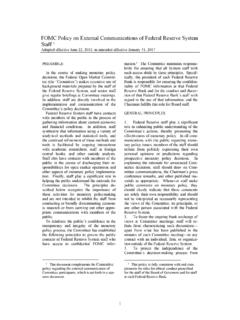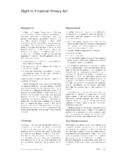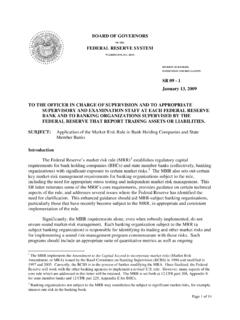Transcription of FAQs on the Calculation of Loan-To-Value Ratio for
1 Board of Governors of the Federal Reserve System Federal Deposit Insurance Corporation National Credit Union Administration Office of the Comptroller of the Currency Office of Thrift Supervision Frequently Asked Questions on Residential Tract Development Lending (September 8, 2005). Purpose The Board of Governors of the Federal Reserve System (FRB), the Federal Deposit Insurance Corporation (FDIC), the National Credit Union Administration (NCUA), the Office of the Comptroller of the Currency (OCC), and the Office of Thrift Supervision (OTS) (the agencies).
2 Are jointly issuing the attached frequently asked questions (FAQs) to assist institutions in complying with the agencies' appraisal and real estate lending requirements for residential tract developments. A residential tract development is a project of five or more units that are constructed as a single development. Overview Institutions employ a variety of credit structures for financing a residential tract development. When the agencies adopted their appraisal and real estate lending regulations in the early 1990s, it was common practice for institutions to provide a developer with a credit facility to fund an entire tract development project or subdivision.
3 More recently, institutions tend to finance land acquisition and development separately from home construction and limit the number of speculative homes under construction at any one time. These trends help institutions to better identify, manage, and control risk to a particular borrower. Recognizing changes in lending practices, the attached FAQs provide clarification on the agencies' appraisal and real estate lending requirements for financing residential construction in a tract development. The FAQs address how institutions determine collateral value and calculate the Loan-To-Value Ratio for these credits.
4 Institutions should review these FAQs in conjunction with the agencies' real estate appraisal and lending regulations and guidelines, including the Interagency Guidelines for Real Estate Lending Policies (lendingguidelines)[SeeFootnote1]and the Interagency Appraisal and Evaluation Guidelines (appraisal and evaluationguidelines).[SeeFootnote2]. Footnote 1. --OCC: 12 CFR 34, C and D; FRB: 12 CFR 208, E and appendix C, and 12 CFR 225, G; FDIC: 12 CFR 323 and 12 CFR 365;. and OTS: 12 CFR 564, and 12 CFR , and 12 CFR NCUA was not a party to the lending guidelines; however, these guidelines, to the extent they are consistent with NCUA Rules and Regulations, establish best practices that credit unions shouldfollow.
5 [EndofFootnote1]. Footnote 2. --The appraisal and evaluation guidelines may be found in: Comptroller's Handbook for Commercial Real Estate and Construction Lending for OCC; SR letter 94-55 for FRB; FIL-74-94 for FDIC; and Thrift Bulletin 55a for OTS. NCUA was not a party to the appraisal and evaluation guidelines; however, these guidelines, to the extent they are consistent with NCUA Rules and Regulations, establish best practices that credit unions shouldfollow.[EndofFootnote2]. Frequently Asked Questions Residential Tract Development Lending (September 8, 2005).
6 1. What is a residential tract development? Answer: The agencies' appraisal regulations define a tract development as a project with five or more units that is constructed or is to be constructed as a single development. For purposes of this document, a unit refers to: a residential building lot; a detached single- family home; an attached single-family home; or a residence in a condominium building. 2. What are the appraisal requirements when an institution finances residential tract developments?
7 Answer: An appraisal for a residential tract development must meet the minimum appraisal standards in the agencies' appraisal regulations and guidelines. Appraisals for these properties must reflect deductions and discounts for holding costs, marketing costs, and entrepreneurial profit. In some circumstances, as discussed in FAQ 11, an institution may rely on an appraisal of the individual unit(s) to meet the agencies' appraisal requirements and to determine market value for calculating the Loan-To-Value (LTV) Ratio .
8 An institution may exclude presold units to determine whether an appraisal of a tract development is required. A unit may be considered pre-sold if a buyer has entered into a binding contract to purchase the unit and has made a substantial and nonrefundable earnest money deposit. Further, the institution should obtain sufficient documentation that the buyer has entered into a legally binding sales contract and has obtained a written pre- qualification or commitment for permanent financing. 3. What are the appraisal requirements when an institution finances raw land, lot development or lot acquisition as part of a residential tract development?
9 Answer: The institution must obtain an appraisal, which includes appropriate deductions and discounts, of the entire tract of raw land or lots. The appraisal should reflect the value of the property in its current condition and existing zoning as well as the market value of land upon completion of land improvements, if applicable. The land improvements may include the construction of utilities, streets, and other infrastructure necessary for future development. An appraisal of raw land to be valued as developed lots should reflect a reasonable time frame during which development will occur.
10 The feasibility study or the market analysis in the appraisal should support the absorption period for the developed lots;. otherwise, a portion of the tract development should be valued as raw land. 2. 4. What are the supervisory LTV limits for residential tract developments? Answer: An institution may lend up to 65 percent of the value for raw land, 75 percent for land development or finished lots, 80 percent for multifamily residential construction, and 85 percent for 1- to 4-family residentialconstruction.
















